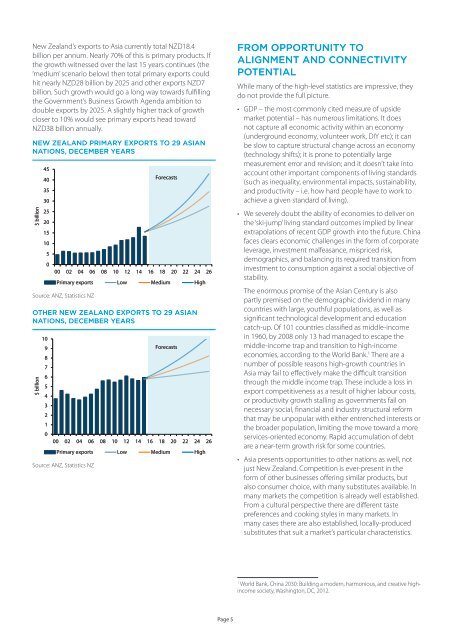New horizons alternative Asian markets – From OPPortUNITY to CONNECtivitY
1sxNzy1
1sxNzy1
Create successful ePaper yourself
Turn your PDF publications into a flip-book with our unique Google optimized e-Paper software.
<strong>New</strong> Zealand’s exports <strong>to</strong> Asia currently <strong>to</strong>tal NZD18.4<br />
billion per annum. Nearly 70% of this is primary products. If<br />
the growth witnessed over the last 15 years continues (the<br />
‘medium’ scenario below) then <strong>to</strong>tal primary exports could<br />
hit nearly NZD28 billion by 2025 and other exports NZD7<br />
billion. Such growth would go a long way <strong>to</strong>wards fulfilling<br />
the Government’s Business Growth Agenda ambition <strong>to</strong><br />
double exports by 2025. A slightly higher track of growth<br />
closer <strong>to</strong> 10% would see primary exports head <strong>to</strong>ward<br />
NZD38 billion annually.<br />
<strong>New</strong> Zealand primary exports <strong>to</strong> 29 <strong>Asian</strong><br />
NATIONS, December years<br />
$ billion<br />
45<br />
40<br />
35<br />
30<br />
25<br />
20<br />
15<br />
10<br />
5<br />
0<br />
00 02 04 06 08 10 12 14 16 18 20 22 24 26<br />
Primary exports Low Medium High<br />
Source: ANZ, Statistics NZ<br />
Forecasts<br />
Other <strong>New</strong> Zealand exports <strong>to</strong> 29 <strong>Asian</strong><br />
NATIONS, December years<br />
$ billion<br />
10<br />
9<br />
8<br />
7<br />
6<br />
5<br />
4<br />
3<br />
2<br />
1<br />
0<br />
00 02 04 06 08 10 12 14 16 18 20 22 24 26<br />
Primary exports Low Medium High<br />
Source: ANZ, Statistics NZ<br />
Forecasts<br />
FROM OPPORTUNITY TO<br />
ALIGNMENT AND CONNECTIVITY<br />
POTENTIAL<br />
While many of the high-level statistics are impressive, they<br />
do not provide the full picture.<br />
• GDP <strong>–</strong> the most commonly cited measure of upside<br />
market potential <strong>–</strong> has numerous limitations. It does<br />
not capture all economic activity within an economy<br />
(underground economy, volunteer work, DIY etc); it can<br />
be slow <strong>to</strong> capture structural change across an economy<br />
(technology shifts); it is prone <strong>to</strong> potentially large<br />
measurement error and revision; and it doesn’t take in<strong>to</strong><br />
account other important components of living standards<br />
(such as inequality, environmental impacts, sustainability,<br />
and productivity <strong>–</strong> i.e. how hard people have <strong>to</strong> work <strong>to</strong><br />
achieve a given standard of living).<br />
• We severely doubt the ability of economies <strong>to</strong> deliver on<br />
the ‘ski-jump’ living standard outcomes implied by linear<br />
extrapolations of recent GDP growth in<strong>to</strong> the future. China<br />
faces clears economic challenges in the form of corporate<br />
leverage, investment malfeasance, mispriced risk,<br />
demographics, and balancing its required transition from<br />
investment <strong>to</strong> consumption against a social objective of<br />
stability.<br />
The enormous promise of the <strong>Asian</strong> Century is also<br />
partly premised on the demographic dividend in many<br />
countries with large, youthful populations, as well as<br />
significant technological development and education<br />
catch-up. Of 101 countries classified as middle-income<br />
in 1960, by 2008 only 13 had managed <strong>to</strong> escape the<br />
middle-income trap and transition <strong>to</strong> high-income<br />
economies, according <strong>to</strong> the World Bank. 1 There are a<br />
number of possible reasons high-growth countries in<br />
Asia may fail <strong>to</strong> effectively make the difficult transition<br />
through the middle income trap. These include a loss in<br />
export competitiveness as a result of higher labour costs,<br />
or productivity growth stalling as governments fail on<br />
necessary social, financial and industry structural reform<br />
that may be unpopular with either entrenched interests or<br />
the broader population, limiting the move <strong>to</strong>ward a more<br />
services-oriented economy. Rapid accumulation of debt<br />
are a near-term growth risk for some countries.<br />
• Asia presents opportunities <strong>to</strong> other nations as well, not<br />
just <strong>New</strong> Zealand. Competition is ever-present in the<br />
form of other businesses offering similar products, but<br />
also consumer choice, with many substitutes available. In<br />
many <strong>markets</strong> the competition is already well established.<br />
<strong>From</strong> a cultural perspective there are different taste<br />
preferences and cooking styles in many <strong>markets</strong>. In<br />
many cases there are also established, locally-produced<br />
substitutes that suit a market’s particular characteristics.<br />
1<br />
World Bank, China 2030: Building a modern, harmonious, and creative highincome<br />
society, Washing<strong>to</strong>n, DC, 2012.<br />
Page 5


